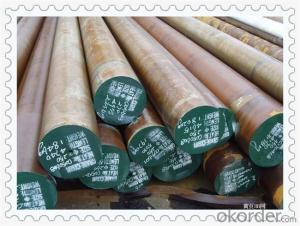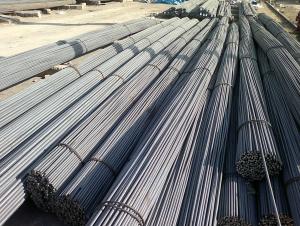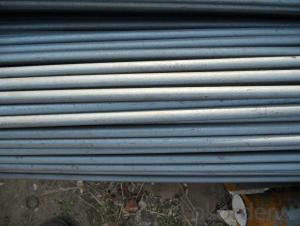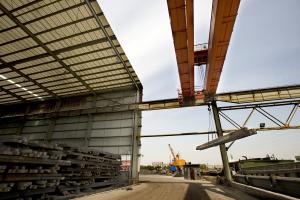Brightly Round Bar
- Loading Port:
- China Main Port
- Payment Terms:
- TT OR LC
- Min Order Qty:
- -
- Supply Capability:
- -
OKorder Service Pledge
OKorder Financial Service
You Might Also Like
Product Description:
Specifications of Bearing Steel Round Bar
Grade | AISI 52100, ASTM E52100, DIN 1.3505,JIS SUJ2, GCr15 |
Dimensions | Diameter: 30-60mm Length: 2000-13000mm or as required |
Shape | Round Bar |
Type | Alloy Steel Bar |
Delivery Condition | Black Surface |
Material | Bearing Steel |
Technique | Hot Rolled |
Usage and Applications of Bearing Steel Round Bar
Bearing steels are used for ball and roller bearing applications and are comprised of low carbon steels and high carbon through harden able steel.


First the famous 1C-1.5Cr steel from which the majority of bearings are made. Its structure is apparently well-understood and the focus is on purity in order to avoid inclusions which initiate fatigue during rolling contact. Then there is the M50 steel and its variants, from which bearings which serve at slightly higher temperatures in aeroengines are manufactured, based on secondary-hardened martensite.
Tapered roller bearing are generally used to support combined load mainly consisting of radial load. Their cups are separable for easy assembling ,During mounting and using, radial clearance and axial clearance can be adjusted and preloaded mounting can be made.
Packaging & Delivery of Bearing Steel Round Bar
Packaging Detail: ASTM 52100 Steel in seaworthy packing or on customer request; Packed in bundles with standard export sea-worthy package or as customer require
Delivery Detail: 45 days after confirmed
Trade terms: FOB, CFR, CIF ou as customer's required
MOQ: 25 tons or at customer's demands. If the quantity is good, the price will be better.
Processing of Bearing Steel Round Bar
The processing of Bearing Steel Round Bar is hot rolled (strictly control sulphur, phosphorus and non-metallic inclusions content and distribution)
Chemical Composition of Bearing Steel Round Bar
C | Si | Mn | Cr | Ni | Cu |
Equal or less than | |||||
0.95-1.05 | 0.15-0.35 | 0.25-0.45 | Cr:1.40-1.65 | 0.30 | 0.25 |
All products' chemical composition and specification can be design according to customers' requirement.
Note of Bearing Steel Round Bar
1. According to national standard (GB) for our products, if not, supply according to national standards (GB) or agreement.
2. We can not only provide electric furnace +LF+VD and electros lag re-melting (ESR) steel forging materials, but also forging products of piece, bar, etc.
3. Our company is equipped with roll equipment and can provide our customers with roll billets or finished.
4. Please send us your detailed specifications when inquire. We will reply to you ASAP.
5. Certificate of quality is issued in English, in addition the normal terms, production process, the mechanical property (yield strength, tensile strength, elongation and hardness. forged ratio, UT test result, Grain size, heat treatment methods and the sample of is shown on the certificate of quality
- Q: What are the advantages of using zinc-alloy steel round bars?
- One of the advantages of using zinc-alloy steel round bars is their high corrosion resistance. The zinc coating acts as a protective barrier, preventing rust and corrosion, which makes these bars suitable for outdoor applications and environments with high humidity. Additionally, zinc-alloy steel round bars have excellent strength and durability, making them ideal for structural and load-bearing purposes. Furthermore, the zinc coating provides enhanced aesthetics, offering a polished and visually appealing finish. Overall, the advantages of using zinc-alloy steel round bars include corrosion resistance, strength, durability, and improved appearance.
- Q: How do you prevent steel round bars from rusting during storage?
- In order to prevent rusting of steel round bars during storage, various measures can be taken: 1. Ensure the round bars are stored in a dry environment: Moisture is a major factor in causing rust. It is important to have a dry storage area that is free from leaks or humidity. Consider using dehumidifiers or moisture-absorbing products to maintain dryness. 2. Apply a rust inhibitor: Coating the steel round bars with a rust inhibitor creates a protective layer that prevents rust formation by blocking moisture and oxygen. Rust inhibitors are available in different forms, such as sprays, oils, or waxes. Follow the manufacturer's instructions when applying the inhibitor. 3. Store the round bars in a climate-controlled area: Fluctuations in temperature can result in condensation, which can lead to rust formation. Storing the round bars in a climate-controlled area with a consistent temperature helps minimize the risk of rusting. 4. Package the round bars properly: Use suitable packaging materials to prevent direct contact between the steel round bars and moisture or other contaminants. Consider wrapping them in plastic or using packaging materials that are resistant to moisture. 5. Regularly inspect and maintain: Periodically check the stored round bars for any signs of rust or damage. If any rust spots are found, clean them promptly and reapply a rust inhibitor to prevent further corrosion. Remember, prevention is crucial in avoiding rust on steel round bars during storage. By implementing these measures, you can greatly reduce the risk of rust formation and maintain the quality of the round bars.
- Q: How do you prevent rusting of steel round bars?
- There are several effective measures that can be taken to prevent rusting of steel round bars: 1. Application of a protective coating is a common method to prevent rusting. This can be done using paint, varnish, or a specialized rust-preventive coating. The coating acts as a barrier, blocking moisture and oxygen from reaching the metal and causing rust. 2. Keeping the steel dry is crucial as moisture is a key factor in corrosion. It is important to store the steel round bars in a dry environment or use dehumidifiers in areas with high moisture levels. 3. Proper ventilation is essential to prevent moisture accumulation around the steel round bars. Good air circulation allows any present moisture to evaporate, reducing the risk of rust formation. 4. Rust inhibitors, also known as corrosion inhibitors, can be applied to the steel round bars. These inhibitors chemically react with the metal surface, forming a protective layer that inhibits oxidation. They can be in the form of oils, waxes, or specialized compounds. 5. Storing the steel round bars in a controlled environment is important if they are not immediately being used. This means keeping them in a dry, temperature-controlled area to minimize exposure to moisture and extreme temperatures, both of which can accelerate rust formation. 6. Regular maintenance and inspection are advisable. It is important to regularly check the steel round bars for rust or damage. Any rust spots should be promptly cleaned and treated with a rust remover or inhibitor to prevent further corrosion. By following these preventive measures, the rusting of steel round bars can be significantly reduced, ensuring their longevity and maintaining their structural integrity.
- Q: Are steel round bars suitable for automotive applications?
- Yes, steel round bars are suitable for automotive applications. Steel round bars are commonly used in the manufacturing of various automotive components due to their high strength, durability, and resistance to corrosion. They are used in applications such as axles, crankshafts, drive shafts, steering components, suspension systems, and chassis construction. Steel round bars provide the necessary strength and rigidity required to handle the demanding conditions of automotive use, including heavy loads, vibrations, and impact forces. Additionally, steel round bars can be easily machined, welded, and forged, making them versatile and adaptable to different automotive designs and requirements. Overall, steel round bars are a reliable and cost-effective choice for automotive applications.
- Q: What are the different surface finishes for stainless steel round bars?
- Different surface finishes can be applied to stainless steel round bars depending on the desired aesthetic appeal and functional needs. Some common surface finishes for stainless steel round bars include the following: 1. Bright Annealed (BA): This finish is achieved by annealing the stainless steel round bar in a controlled atmosphere, resulting in a smooth and highly reflective surface. It is often used for decorative purposes due to its mirror-like appearance. 2. Mill Finish: Also known as hot rolled or hot-rolled annealed and pickled (HRAP), this surface finish is the untreated surface directly from the mill. It has a rough and pitted texture, making it suitable for industrial applications where appearance is not the main concern. 3. Satin Finish: Also referred to as brushed or dull polished finish, this surface finish is achieved by brushing the stainless steel round bar with a fine abrasive material. It creates a soft and matte appearance with visible parallel lines. 4. Polished Finish: This finish is achieved by progressively using finer abrasive materials to polish the surface of the stainless steel round bar. It results in a high-gloss, mirror-like finish that is commonly used for decorative purposes. 5. Ground Finish: This surface finish is achieved by grinding the surface of the stainless steel round bar using abrasive belts or wheels. It creates a uniform and smooth surface with a matte appearance. 6. Bead Blasted Finish: This finish is achieved by bombarding the surface of the stainless steel round bar with small glass beads at high pressure. It creates a uniform and matte appearance with a slightly textured feel. 7. Electropolished Finish: This finish is achieved by immersing the stainless steel round bar in an electrolytic bath and applying an electric current. It removes a thin layer of material, resulting in a smooth and shiny surface with improved corrosion resistance. Each surface finish possesses its own distinct characteristics and is selected based on the specific requirements of the application.
- Q: Can steel round bars be used in food processing industries?
- No, steel round bars are generally not suitable for use in food processing industries as they can corrode and contaminate the food. Stainless steel, on the other hand, is commonly used in such industries due to its corrosion resistance and hygienic properties.
- Q: Can steel round bars be used for making bicycle frames or handlebars?
- Yes, steel round bars can be used for making bicycle frames or handlebars. Steel is a commonly used material in bicycle manufacturing due to its strength, durability, and affordability. Round bars made of steel provide excellent rigidity and stability, which are essential for ensuring the structural integrity of a bicycle frame or handlebars. Additionally, steel has a high tensile strength, allowing it to withstand the stresses and strains experienced during cycling. It is worth noting that different types of steel, such as chromoly steel, may be preferred for bicycle frames and handlebars as they offer specific advantages such as improved strength-to-weight ratio. However, in general, steel round bars are a suitable choice for constructing bicycle frames and handlebars.
- Q: What are the differences between hot rolled stainless steel rounds and cold drawn round ones?
- Round bar is divided into three parts: hot rolling, forging and cold drawing. Standard Specification for hot rolled round steel is 5.5-250 mm. Where: 5.5-25 mm small round steel mostly straight bundles of supply, used for steel, bolts and various mechanical parts; greater than 25 mm round steel, seamless steel pipe is mainly used for the manufacture of mechanical parts of the tube, etc..
- Q: Can steel round bars be used in the production of agricultural machinery?
- Indeed, the utilization of steel round bars is applicable in the fabrication process of agricultural machinery. Owing to their robustness, longevity, and adaptability, steel round bars are frequently employed in the creation of diverse agricultural machinery elements and constituents. These bars serve as ideal materials for constructing pivotal parts like axles, shafts, gears, and brackets, which are indispensable for the smooth functioning of agricultural machinery. It is worth noting that steel round bars can be effortlessly machined and welded to meet precise design prerequisites, rendering them an optimal selection for manufacturers involved in agricultural machinery production.
- Q: Can steel round bars be used for making gates?
- Yes, steel round bars can be used for making gates. Steel round bars are strong and durable, making them suitable for gate construction. They can be welded together to create a sturdy gate frame, and can also be used for decorative elements or as pickets. Additionally, steel round bars can be easily customized and shaped to fit the desired gate design.
Send your message to us
Brightly Round Bar
- Loading Port:
- China Main Port
- Payment Terms:
- TT OR LC
- Min Order Qty:
- -
- Supply Capability:
- -
OKorder Service Pledge
OKorder Financial Service
Similar products
Hot products
Hot Searches
Related keywords
























